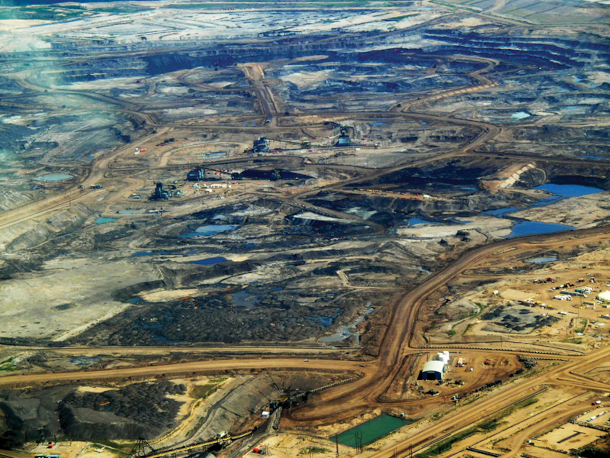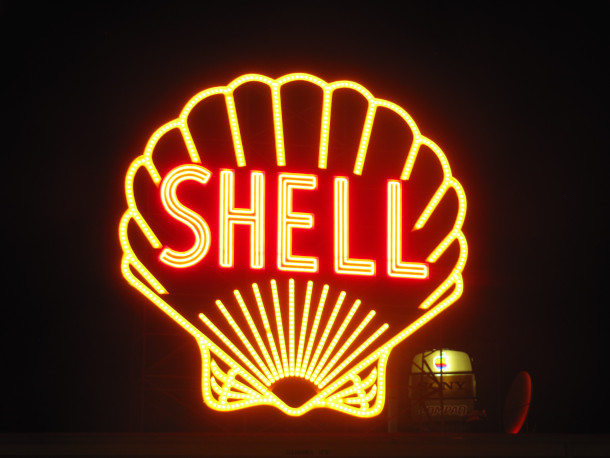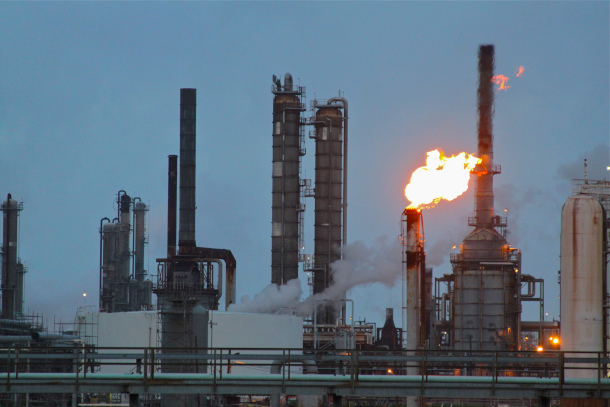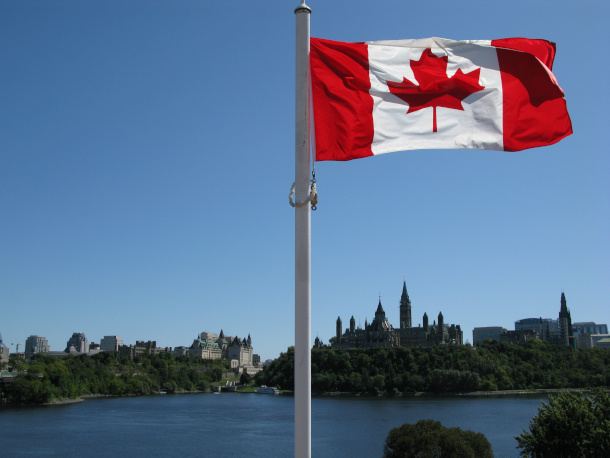Phantom Carbon Credits
Air Date: Week of May 17, 2024

Oil and gas fuel is Canada’s largest export, and much of that oil comes from the country’s tar sands. Shell’s Quest project was the first major carbon capture project serving Alberta’s tar sands production. (Photo: Dru Oja Jay/Howl Arts Collective, Flickr, CC BY 2.0)
Shell’s flagship carbon capture and storage project in Canada generated millions of dollars in carbon credits based on greenhouse gas emission reductions that never took place. According to a study by Greenpeace Canada, the scheme was part of Shell’s billion-dollar Quest carbon capture project. While these phantom credits were legal from 2015 to 2021 under approved carbon tax rules, Shell’s actions raise questions about carbon capture practices in Canada’s lucrative fossil fuel industry. Living on Earth’s Steve Curwood spoke to Greenpeace Canada researcher Keith Stewart.
Transcript
O’NEILL: It’s Living on Earth. I’m Aynsley O’Neill.
BELTRAN: And I’m Paloma Beltran.
The multinational petroleum giant Shell has a plant in Alberta, Canada that traded millions of dollars worth of carbon credits based on greenhouse gas emission reductions that never took place. According to a study by Greenpeace Canada, the scheme was part of Shell’s billion-dollar Quest carbon capture project from 2015 to 2021. For every ton of carbon Shell secured underground, they got credit for two tons, under the Canadian carbon tax system. While these phantom credits were surprisingly legal, Shell’s actions raise questions about carbon capture practices in Canada’s lucrative fossil fuel industry. Greenpeace Canada researchers say they publicized Shell’s actions to avoid the pitfalls of the past, as Canada formulates new carbon credit regulations going forward. Living on Earth’s Steve Curwood spoke with Keith Stewart, a senior energy strategist with Greenpeace Canada.
CURWOOD: What we're going to talk about here is perfectly legal, but from your perspective, from many people's perspectives, not exactly ethical. How fair is that to say?
STEWART: That's totally fair. I have been telling all my friends about this for a while now. And every time they hear it, they're like, that can't be legal, is it? And I'm like, oh, no, it's entirely legal. It's literally written into the law, but I don't think it's right.
CURWOOD: So, Canada has a friendly, benign international reputation. But how does that stack up when we consider fossil fuels and the challenge of climate disruption?
STEWART: Yeah, Canadians, we like to think of ourselves as Boy Scouts on the international stage, you know, helpful, not that powerful, but you know, generally nice. But when it comes to fossil fuels, we're a giant. We're—oil and gas is our largest export, we're one of the largest exporters of oil and gas in the world, we have the third largest reserve of oil in the world. And our oil is particularly high carbon in the tar sands, and just about over half of Canadian oil comes from the tar sands. So it's dirty, it's expensive, we're sending it all over the world, and most people don't know that.

Until its two-for-one deal ended, for each ton of carbon that Shell captured as part of its Quest project, it was able to obtain two tons worth of carbon credits. (Photo: Catherine Hammond, Wikimedia Commons, CC BY-SA 3.0)
CURWOOD: Talk to me, for example, about the regulations around making credits for carbon in Canada there, in the context of carbon capture.
STEWART: Canada's oil industry has been pitching carbon capture for a long time, it's kind of their silver bullet solution to pollution: Don't worry, we don't have to phase out of oil and gas. And yes, we have really high-carbon oil, but we're going to do this carbon capture, and we'll sort of like reduce carbon emissions, and it'll all be great. And the Quest project was the first one to do this in the tar sands area. And it captures just under a million tonnes per year. And right now, one of the reasons we did this report is because right now, the oil companies are under a lot of pressure to reduce emissions, because they're the biggest source. And so they're saying, okay, we can do more of this carbon capture stuff, we can capture, you know, 10 or 12 billion tonnes per year if governments give us enough money, and the government right now, the federal and provincial governments are offering to cover 62% of the costs. That's a lot. I mean, these companies are rolling in cash, they are bringing in cash like never before, they're having record-breaking profits. And yet, they're saying, you know, the governments have offered to cover the majority of costs of doing this, and the oil companies are still saying, that's not enough. We need more. And we've seen this movie before. This is exactly what happened with Quest. The provincial government offered to cover 60% of costs of this one, it's because it's, you know, the first time they're doing it, it’s a trial thing. Shell said, no, that's not good enough, we need more. And so they came up with this special deal for that project, where for each tonne that Shell sort of pumped underground, they got to sell two tonnes of carbon credits, to make extra money. And it resulted in them getting a lot more money over the life of this project. And we're sort of looking at that thinking, you know, this is not a great idea. And we're partially raising this now because we want to make sure it doesn't happen again because right now they're negotiating over this new deal. We're bringing in regulations to limit greenhouse gas emissions from the oil sector, they're fighting back hard against them. And we want to make sure there aren't these kinds of loopholes put into the new rules that are being proposed right now. So let's look at what happened last time and make sure we don't make the same mistakes.
CURWOOD: They pumped this carbon into the ground, what would they do to get carbon credits? What would they get paid? What was this all worth?

According to Keith Stewart, the pricing system used by Shell’s Quest project leads to more pollution since it allows the company to profit from emissions reductions that never happened, incentivizing more emissions. (Photo: Roy Luck, Flickr, CC BY 2.0)
STEWART: In Canada, we actually have a carbon pricing system. So companies have to pay for their emissions. It's a very complicated system, but it's basically, on some of their emissions, they pay a certain amount per tonne, it started at $30 per tonne, and, you know, went up to $50 per tonne. So the idea with this project is for each tonne that they pump underground, Shell or whoever they sell the credits to doesn't have to pay that $30 a tonne. So it's worth $30 a tonne to them. And that's how they get revenue for doing this. And Shell, however, worked a special deal where for each tonne that they put underground, they got to sell two of those credits. And so they could get initially $60 a tonne, rather than 30. But the problem then is it just means you're selling emissions reductions that never happened, which means we're getting more emissions put out into the air, because otherwise it would have had to been reduced. And so it's kind of countering the actual potential good thing that comes from this if the carbon stays underground forever, by letting other companies pollute more.
CURWOOD: Those were the regulations then--what about now?
STEWART: This two-for-one deal was ended in the end of 2022. And they never said exactly why they're end—it’s partially that price of carbon emissions has been going up. So it's currently like $85 a tonne. So they no longer need that extra money. But it was also, I suspect, because the federal government kind of forced Alberta to change their system. The federal government had won a Supreme Court case saying they were allowed to do industrial carbon pricing. The federal government said, okay, Alberta, you've got to meet our minimum standards. Previously Alberta—because Alberta challenged it to the Supreme Court and said, this is illegal, the federal government can't make us do this. Now they submitted, okay, they're making us do it. So I think what happened was the federal government kind of said, okay, no more of this two-for-one stuff.
CURWOOD: What are the numbers that we're talking about here? How much carbon was sequestered here, and how many carbon credits were issued under this Quest program by Shell?

Canada has a complex carbon pricing system. Taxpayers paid much of the cost of the Quest carbon capture system through subsidy programs. (Photo: Karim Rezk, Flickr, CC BY-NC-ND 2.0)
STEWART: Well, as of the end of 2022, Shell had buried 5.7 million tonnes of emissions, and had got those credits for those 5.7 million tonnes, and then an additional 5.7 million tonnes through this two-for-one deal. And the sale of those put together was worth $400 million. So they got—well, 406. So they got $203 million for selling those, you know, additional, what we would call phantom credits, for reductions that didn't really happen.
CURWOOD: So what did this project then cost Canadian taxpayers?
STEWART: Taxpayers paid about $750 million in direct subsidies, and then another $200 million in what we would call these phantom credits. So in the end, when you add those two together, it was 93% of the total costs of the project were basically paid through these subsidy programs. And in the end, Shell actually made an 11% profit on it so far, but they only managed to get this positive return by selling those extra credits. And that's why they sort of worked this deal, but, you know, we would say these are some of the richest companies in the world are these big oil companies. The average Canadian taxpayer shouldn't be paying 93% of their costs to clean up their pollution, we have this principle called polluter pay, the polluter should actually pay to reduce, not be putting out their hand to the taxpayer for that money.
CURWOOD: What prompted you to take a look at these carbon credits in the Quest program?
STEWART: We started this investigation because we know there's going to be some kind of credit trading system in the new cap system that's being brought in. And we're trying to sort of say, okay, what exactly happened with this the last time, and make sure that these kinds of backroom deals, kind of like, you know, you could find out about them, if you know exactly where to look, we want to make sure that those aren't happening again. And that's—we’re going to pull these negotiations out of sort of back rooms and sort of quiet negotiations into the public, so the public really knows what's being done on their behalf by decision makers. You've got to watch closely what's happening because oil and gas has some of the best lobbyists in the country, some of the best lobbyists in the world, frankly, and they're going to try and get the best deal possible. And we want to make sure that we're watching from the other side, to protect planet and pocketbooks of the average person. So we took a look at the Quest program because in many ways it's pointed to as the poster child for how to do this. It's the example that's always used as, oh, here's this great program in Canada that's sort of capturing all these emissions. And we said, okay, well, let's look under the hood and see exactly how good this is. And when you see something like these double credits, I mean, completely undermines the integrity of the whole system.

Keith Stewart is a senior energy strategist with Greenpeace Canada. (Photo: Courtesy of Keith Stewart)
CURWOOD: Your research shows that there were some very clever moves made by the oil and gas industry around these regulations when it came to accounting for these carbon credits. What about the technology itself? How well does it really work?
STEWART: There's two kind of issues with carbon capture. One are just the technical thing: is it going to work over the long term? What we've seen is a lot of the projects have been built haven't worked very well. Quest works better than most to be honest. This kind of technology works well for certain types of applications, where there—you’re really concentrated stream of carbon dioxide. It doesn't work as well for more diffuse ones. A bunch of times when they tried to put it in a coal plant, it really hasn't worked well. It's application specific as to how well it works. But then there's all the issue of, once you put this stuff under the ground, will it stay there? And the oil industry assures us, oh, no, it'll stay down there forever. And like, well, we've got a lot of leaking oil and gas old wells that were supposedly plugged here in Canada.
CURWOOD: Keith, how do you feel about this whole thing?
STEWART: We're at a really critical time in the fight against climate change. And I just think it's so important that we go all in on real solutions. And part of this is going to have to be fighting back against the oil industry lobbyists who want us keep us sort of stuck in the energy system of the past. And so I think we undertake this kind of research because we want to, like, pull back the curtain, let people see what's happening behind the scenes, these types of behind-the-scene negotiations. And I think when people see that, they're gonna, like, push for those real solutions. And I think it's, you know, we need people to get involved, because we really don't have any time to waste on getting action on real climate solutions now.
BELTRAN: That’s Keith Stewart of Greenpeace Canada, speaking with Living on Earth’s Steve Curwood. Shell has said in press reports including the Financial Times that their carbon capture plan, quote, “played an important role in helping to decarbonize industry and sectors where emissions cannot be avoided.”
Links
Read the Greenpeace report on Shell’s Quest carbon capture and storage project:
Financial Times| “Shell Plant Reported Millions of ‘Phantom’ Carbon Credits”
Shell’s blog post responding to the Financial Times article:
Explanation of carbon pricing from the government of Canada:
Living on Earth wants to hear from you!
Living on Earth
62 Calef Highway, Suite 212
Lee, NH 03861
Telephone: 617-287-4121
E-mail: comments@loe.org
Newsletter [Click here]
Donate to Living on Earth!
Living on Earth is an independent media program and relies entirely on contributions from listeners and institutions supporting public service. Please donate now to preserve an independent environmental voice.
NewsletterLiving on Earth offers a weekly delivery of the show's rundown to your mailbox. Sign up for our newsletter today!
 Sailors For The Sea: Be the change you want to sea.
Sailors For The Sea: Be the change you want to sea.
 The Grantham Foundation for the Protection of the Environment: Committed to protecting and improving the health of the global environment.
The Grantham Foundation for the Protection of the Environment: Committed to protecting and improving the health of the global environment.
 Contribute to Living on Earth and receive, as our gift to you, an archival print of one of Mark Seth Lender's extraordinary wildlife photographs. Follow the link to see Mark's current collection of photographs.
Contribute to Living on Earth and receive, as our gift to you, an archival print of one of Mark Seth Lender's extraordinary wildlife photographs. Follow the link to see Mark's current collection of photographs.
 Buy a signed copy of Mark Seth Lender's book Smeagull the Seagull & support Living on Earth
Buy a signed copy of Mark Seth Lender's book Smeagull the Seagull & support Living on Earth

